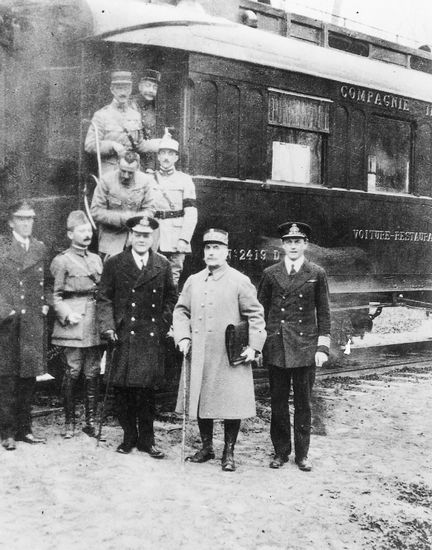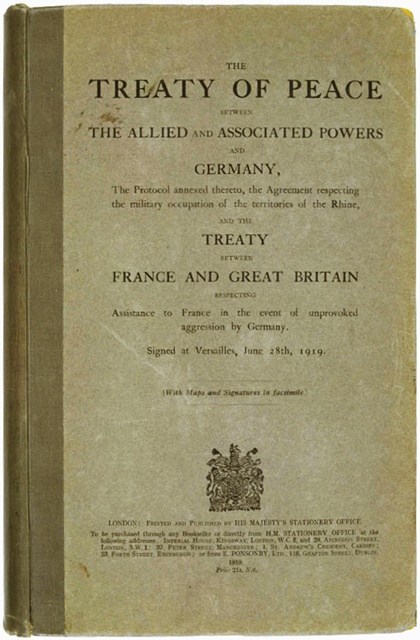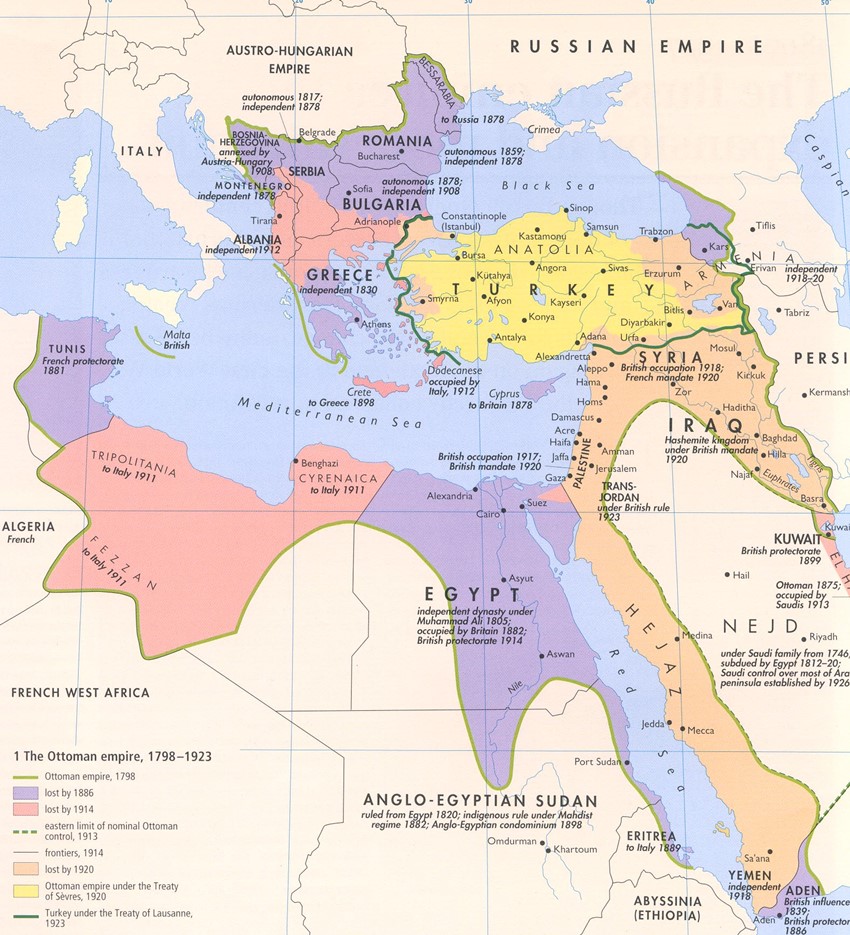Armistice and Versailles
Approaching Peace
On November 3rd, as the Canadians left Valenciennes and moved towards Mons, Austria-Hungary withdrew from the war. Popular dissatisfaction with the conflict and the accumulating losses of the Central Powers pressured further towards an end to the fighting. In fact, after the Spanish Flu epidemic of mid-1918 which took millions of European lives, the public on all sides of the 4+ year battle felt that they had seen enough death and destruction. The Central Powers themselves realized they would not be able to fight for much longer.
Throughout October of 1918, various discussions and political maneuvers were occurring both amongst and between the Big 3 (Britain, France, U.S.) and the Central Powers. The dominant theme of those activities was armistice. Ludendorff, who had told his fellow German leaders in late September that the German army was finished, changed his tune after seeing the terms of armistice in mid-October. He deemed the terms, modelled on U.S. President Wilson’s 14 points, unacceptable and he wanted to fight on. Even Britain, France, the U.S., and Italy could not agree on the conditions. On the 6th of November, the Germans sent a delegation to France to discuss terms for an armistice and then on the 9th, Kaiser Wilhelm II abdicated.
The Armistice Agreement
Matthias Erzberger, leader of the German delegation, travelled through the destruction that was the Western Front and arrived in northeastern France only to be put aboard French General Foch’s train and moved to the Compiegne Forest. There was little negotiation during Erzberger’s 3 days on the train. The German side was not in a favourable position and once the Kaiser’s abdication was known, it was not long before Erzberger was instructed by a German government official to sign.
The Conditions:
– Ceasefire in 6 hours (The agreement was signed at 05:00 on 11 Nov 1918 to be effective at 11 a.m.)
– Immediate release of all prisoners of war
– Immediate surrender of all weaponry and war machinery
– Removal of all Central Power soldiers from conquered land with 15 days
– Acceptance of the occupation of the Rhineland by an Allied force
– Renunciation of the Brest-Litovsk and Bucharest treaties
– Agreement to pay reparations
– Identification of and information sharing pertaining to all booby traps and/or sabotaged resources (e.g. poisoned wells, etc.) within 2 days
– If any conditions were not met, hostilities would begin anew within 48 hours
Lost Soldiers (all belligerent nations)
60 000 000 men mobilized
21 000 000 soldiers wounded
8 500 000 soldiers dead
7 000 000 men permanently disabled
5 000 000 civilian deaths
> 20 000 000 Spanish Flu deaths worldwide
The Treaty of Versailles
The Paris Peace Conference of 1919
The peace agreement that formally brought the Great War to an end was signed in Paris on June 28, 1919 at the Palace of Versailles inside its Hall of Mirrors, exactly 5 years after the assassination of Archduke Ferdinand by Princip. Similar to the Armistice terms, the British, French, and American (the Big 3, the Big 4 if Italy’s Vittorio Orlando is included) leaders could not agree on which articles should be presented to the Central Powers. David Lloyd George, Georges Clemenceau, and Woodrow Wilson respectively, each had their own goals with regard to what they were trying to get Friedrich Ebert, the main German representative, to sign-off on. The Central Powers saw the Treaty as a diktat, in that they had no choice but to accept or be attacked or punished further. Even amongst the Big 3 there was discord in regard to what was and was not included in the treaty document.
There were 4 parts to the Versailles Treaty. They pertained to:
1) Territory: all occupied land was returned; German colonies were taken and distributed; Treaty of Brest-Litovsk was scrapped (see more details below).
2) Military: Germany is only allowed an army of 100 000 men; no tanks, planes, subs are allowed; the land along the Rhine River in western Germany is classified as a demilitarized zone.
3) Economy: Reparations must be paid; no alliance with Austria is permitted (to prevent economy from getting too strong).
4) General:
(i) War Guilt Clause: Germany must take responsibility for starting and creating the war.
(ii) Reparations: Germany owes France and Belgium 6.6 billion dollars (just over 500 billion in today’s dollars).
(iii) The League of Nations will be created to ensure peace.
If any of the treaty articles were violated, the offending nation could be invaded.
The 3 components of the League of Nations:
(i) the Assembly:
a group of representatives from all member nations that could review, discuss, or act to solve any presented issues,
(ii) the Council:
between 8 and 15 representatives elected from the Assembly that would act to govern the League’s business, and
(iii) the Secretariat:
a body of experts under the Secretary General that advised and provided information to the Assembly and Council.
Although, the American President Woodrow Wilson was one of its largest proponents, the United States would not join the League of Nations because Congress did not agree with the aggression clause in Article X. In fact, Article X and the consequent refusal by the U.S. to join, made the League of Nations weak from its inception, not to mention that those who were defeated in the Great War still carried much resentment and saw the organization as the League of “Victors”. The League however, did work quite well until the 1930’s. At that time a few nations pulled out and some of the conditions of the Treaty of Versailles were broken (Germany, Hitler, in 1933 refused to continue paying reparations). By the time that the Second World War broke out in 1939, it was already apparent that the League had passed its best before date, and in 1946, a redesigned system known as the United Nations, replaced it.
Setting the Table for the Second World War:
An Honourable Fight --OR-- To the Winners go the Spoils?
Perhaps one of the events that most negatively impacted the future was the Sykes-Picot Agreement. It was a secret Entente agreement made in 1916 (between Britain, France, and Russia) that would divide the Ottoman Empire amongst themselves if victorious in the Great War. Unexpectedly, the Bolsheviks published the secret agreement in Nov. 1917 during the Russian Revolution. This caused Britain and France to look bad to their allies, as well as lose the trust of their supporters in the Arab world (Britain had already made promises to the Arabians that were impossible if Sykes-Picot went forward). There were also talks of creating a Jewish state and a Palestinian state, but because of incompatible promises to both, neither occurred.
Other Treaties Negotiated at Versailles: Further Embedded Distrust and Discord
The division of occupied land and the segmenting of areas formerly under control of various empires continued to generate friction and strife as the world moved into the 1920’s.
This split up the Austrian portion of the Austro-Hungarian (Hapsburg) Empire into multiple parts.
A smaller Austria resulted when the new states of Czechoslovakia, Poland, and Yugoslavia (future Balkans) were each created and land was given (ceded) to Italy, Poland, and Romania.
This split up the Hungarian part of Austro-Hungarian Empire.
A smaller Hungary was created with land being ceded to Czechoslovakia, Poland (Galicia), Romania (Transylvania), and Yugoslavia.
This split up the Ottoman Empire (see the map below).
The Treaty of Sevres created the new states of Armenia, Syria and Lebanon (Note: see Lausanne), Palestine, the Kingdom of Iraq, and the Kingdom of Hejaz (Arabian Peninsula).
Land from the vast Ottoman Empire was ceded to Italy and Greece. A demilitarized zone was created in the Bosphorus and Dardanelles. “Free” middle-eastern ports situated on the Mediterranean Sea and the Persian Gulf were created. The treaty tried to establish a Kurdistan but an agreement amongst Kurds and Armenians could not be reached.
When considering that one hundred years ago the Big 3 mapped many of these new lines onto paper at a negotiation table, and consequently divided communities and families, the student of history can begin to better understand the conflict, strife, and socio-cultural friction that is constant in these areas today.
It also must not be forgotten that in some areas before the Great War had even began, conflict had already existed between various groups.
The Table is Set
Although the Great War had ended and a peace treaty had been signed, there were still many unhappy individuals and nations that were dealing with an abundance of social discontent simmering beneath the surface. Many Germans were resentful of the Big Three because they felt that they were being gratuitously punished. The piling of the reparation debt atop the already struggling and economically drained German population insulted and further complicated the lives of many. As a result, in 1921, the new Weimar Republic of Germany began to experience a currency hyperinflation that would further devastate them financially, until finally ending in 1924.
France was happy for the war to end but also seemed to want to crush Germany further. Both Russian and German societies had experienced tastes of revolution and many European nations were experimenting with new structures in government and society (Socialism, Communism, Bolshevism, Fascism). In addition, many people the world over blamed the breakout of the Spanish Flu and the consequent loss of millions upon millions of lives on the belligerents of the Great War, their inability to stop the fighting, and the disease-ridden conditions.
There were so many different things going on in the world in the 1920’s, both positive and negative, that few knew what to expect for the future. Once into the 1930’s, the mood changed and many thought that globally, things were not improving. North America dealt with a major drought and market crashes. Germany began to remilitarize and Spain experienced a civil war (1936-39). The Union of Soviet Socialist Republics, led by Joseph Stalin, began to cooperate and partner with the West (U.S., Britain), while also supporting nationalist forces that were opposing fascism in Spain, Italy, and Nazi Germany. What would the future hold?
Unit Home
Russian Revolution. Gaining the U.S. Overstrength Corps. Canadian Op.'s 1915-18.
Ending the War Quiz
1918. Canadian Corps. Final 100 days. Battles. Lives Lost. Treaties.





